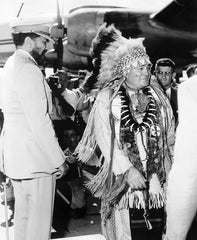- Continue Shopping
- Your Cart is Empty
"Oklamopia"
In the early days of the DoubleShot, when we were just beginning to understand the magic that Ethiopia brings to coffee, an interesting story opened up to me that brought that world from across the sea right home to Oklahoma.
Two greying men met at the DoubleShot a couple of days per week. They would sit at ease and drink our drip coffee and leisurely converse. If you wandered near their table at any point you might hear them discussing politics or current events or some philosophical point of which they’d plenty of time to ponder. The discourse was one monologue with plenty of air between words, unhurried and immersive, followed by the other rebutting or augmenting the previous assertions. And this would go on until they figured they should mosey on to who-knows-where. It reminded me of the coffee breaks my grandpa would take in the afternoons, meeting daily at Hy-Vee’s grocery cafe or Hardee’s restaurant, seemingly unplanned yet unsurprised to see his buddies.
One day, one of these older gentlemen came to me with unusual and mysterious items in hand. He told me he had been a professor at OSU and taught in Ethiopia for a few years. He handed me a primitive wooden mortar approximately one-foot tall, which he said was “an Ethiopian coffee grinder.” I envisioned a woman roasting coffee beans in an iron bowl over a small mound of coals and then pulverizing them in this hollowed-out log. Ethiopia is one of the only countries who maintain a custom of drinking the coffee they produce. Most coffee-producing countries export their entire crop and leave the coffee drinking for Nescafe. Ethiopians have a lengthy, unhurried coffee ceremony that my grandpa would appreciate. They take fresh roasted coffee to the extreme, much like I did in the beginning of my roasting exercises - pouring coffee from roaster to grinder to brewer to cup, all within minutes. Coffee is indigenous to Ethiopia. And after the storied discovery of coffee’s restorative powers, the development of its consumption moved from eating the cherries to consuming the raw seeds mixed with animal fat, to drinking wine from the fruit pulp. And who devised the amazing plan of roasting its seeds and extracting their goodness with water? No one really knows. But though the consumption of coffee had evolved, the cultivation and processing of coffee had remained a wild, anecdotally-driven avocation in Ethiopia for centuries.
In August 1952 a group of six Oklahoma A&M (now OSU) staff members arrived in Ethiopia in order to determine a suitable site for The Imperial Ethiopian College of Agriculture and Mechanical Arts. At that time a survey had been done and it failed to find a single Ethiopian national with the equivalent of a B.S. degree in any phase of agriculture. OSU had commenced the construction of an agriculture school in Ethiopia with funding from USAID. With the assistance of the Emperor Haile Selassie (hereafter referred to simply as “King of Kings, Conquering Lion of the Tribe of Judah, Elect of God, Emperor of Ethiopia” or alternatively, “His Imperial Majesty”) the school was located in the famous coffee-growing region of Harrar, with a junior college in Kaffa and one near the capital city of Addis Ababa. The goal of this project was to teach Ethiopians about the scientific and industrial progress in agriculture, and to educate enough Ethiopians to take over the administration of these institutions as soon as possible. The main focus of the college was on food farming and coffee cultivation. OSU operated in Ethiopia from 1952-1968, when there were enough nationals to fill the staff. During that time 384 people graduated, most becoming ministers of Agriculture and Education. And 136 students went on to pursue advanced degrees in the United States before returning to teach at the college or work in the Ethiopian government.
 The professor who gave me the mortar for crushing coffee also gave me an elaborate charcoal drawing of one of Haile Selassie’s Imperial Guards, or Kebur Zebagya. He told me one of his Ethiopian students drew this and gave it to him. The drawing is signed "Kiros Woldu" and dated ’65. I love this piece of art and it hangs on the brick wall behind my roaster. It’s a reminder of our connection with Ethiopian coffee farmers through OSU and the professor who spent so many days chatting at our tables.
The professor who gave me the mortar for crushing coffee also gave me an elaborate charcoal drawing of one of Haile Selassie’s Imperial Guards, or Kebur Zebagya. He told me one of his Ethiopian students drew this and gave it to him. The drawing is signed "Kiros Woldu" and dated ’65. I love this piece of art and it hangs on the brick wall behind my roaster. It’s a reminder of our connection with Ethiopian coffee farmers through OSU and the professor who spent so many days chatting at our tables.
Bekele Dukale lives in the Gedeb region of Ethiopia. He owns a farm that is about 5 hectares in size, which is the equivalent of 12 acres or the size of 10 football fields. That’s a pretty big farm in Ethiopia. Bekele grows coffee and sells it to a mill called the Worka Cooperative. This is a place that buys coffee cherries and dries them, and then processes the coffee to be sold through the Ethiopian Coffee Exchange or through a private exporter. Bekele has enough land and is producing a high enough quality for the mill to separate his coffee into a micro-lot. This is fairly unusual for Ethiopia.
Gedeb is southeast of the Yirgacheffe region, which is well-regarded as producing the best coffees in the world. The reasons for this are likely the high elevation, the microclimates, and the age-old heirloom varieties of coffee that are growing in the area. Though Gedeb is designated as a separate region, it is home to some of the same types of coffees, and is supposedly the highest place in the country where coffee is cultivated.
Coffees are graded for export. Each coffee-producing country has different grading practices and designations, some based on bean size, others on its elevation, etc. In Ethiopia, coffees are graded 1-9 based on visual inspection for defects and on cup quality. Up until just a couple of years ago, a grade 1 Natural was unheard-of. And it’s still a very stringent designation because the natural variance in dry-processed coffee beans is something that must be minimized by careful harvesting, hand sorting, and meticulous milling.
This year I bought coffee that was grown by Bekele Dukale. I’ve never been to Ethiopia, nor have I met Bekele. I bought the coffee from my friend Peter at Royal Coffee, which is a specialty broker in Oakland. This coffee is a grade 1 natural, 100% grown by Bekele Dukale in Gedeb, and dry processed at the Worka Cooperative. This is one of the holiday coffees we are offering this year to help you celebrate with family and friends, at home by yourself in front of the fireplace with a good book, or with someone special. The coffee roasts beautifully. It is consistent and even in color. In the cup, it has a very soft mouthfeel with lots of dark chocolate and cinnamon. Notes of pear and strawberry peak through, not in an invasive way, but just to tickle your more extravagant sensibilities. I love it and I know you will too. Our pastry chef, Curtis, developed a beautiful and simple food pairing for this coffee, based on a rustic French dish called clafoutis (apparently pronounced claw-foo-tee’). Buy a pound at the DoubleShot or online and we’ll send you the recipe card with instructions and a mouth-watering picture.
I can’t consume any dairy, so clafoutis is out of the question, but my friend Mark Brown suggested another pairing for Bekele’s coffee, and it’s one I am really enjoying. From Mark’s food publication, argentfork:
chocolate pear crumble
I tossed one of these together for some
friends last month who barely saved me
any. I did one similar for the woman who
taught us French when we were in France.
She said, “Mark … c’est incroyable.” And it
was. Butter the bottom of a baking dish big
enough to accommodate your pears. Half or
slice or chunk the fruit—it must be ripe—and
lay over it the best chocolate you can afford.
About 4 ounces. Top that with a mixture
of flour, butter and sugar, and maybe even
a little cornmeal for bite. Any old crumble
pastry will do. Bake until golden.
On June 18, 1954, the Ethiopian Emperor, Haile Selassie came to Oklahoma to visit OSU (then known as Oklahoma A&M College). He was visiting in order to show his appreciation for the initiative that the president of Oklahoma A&M College had taken to reach out to his country to develop an international program for educational aid. The colleges that OSU set up in Ethiopia were the first in a new program called the Point Four Program, announced by Harry S. Truman in his inaugural address in 1949. The Emperor’s visit was apparently quite a society event, and 300 of the “elites” of Oklahoma were invited to a formal dinner. Afterward, His Imperial Majesty stood in a reception line for an hour and forty minutes shaking hands and greeting 1,600 people.
 Two things stick in my mind about the Ethiopian Emperor’s visit. First, Haile Selassie had requested, while in Oklahoma, to meet an Indian. So upon his arrival he was greeted by a well-known native american named Acee Blue Eagle, who was in traditional dress, and he presented the Emperor with an Indian war bonnet. And second, after the formal dinner, Oklahoma Governor Johnston Murray gave a welcoming speech, during which he bungled the pronunciation of Ethiopia, calling it “Oklamopia.”
Two things stick in my mind about the Ethiopian Emperor’s visit. First, Haile Selassie had requested, while in Oklahoma, to meet an Indian. So upon his arrival he was greeted by a well-known native american named Acee Blue Eagle, who was in traditional dress, and he presented the Emperor with an Indian war bonnet. And second, after the formal dinner, Oklahoma Governor Johnston Murray gave a welcoming speech, during which he bungled the pronunciation of Ethiopia, calling it “Oklamopia.”
I searched the list of college graduates during OSU’s time in Ethiopia, but I didn’t find the name Bekele Dukale. No surprise, because the graduates seemed to be from the wealthier families of Ethiopia, emerging into teaching and governing jobs, or if into private farming, it was generally a large enterprise. But the advancements made in farming technologies and education of farming methods, experiments with varieties and processes, and the general imprint made on the culture of coffee farming in Ethiopia by the schools from the OSU/USAID program were wide-reaching. It is because of this dissemination of information and practical knowledge that a man like Bekele Dukale could learn to produce the highest quality of coffee from the finest coffee-producing region in the world. It’s a testament to the foresight in the 1950s by a handful of leaders in Oklahoma and Ethiopia that today one of the best coffees in the world was grown in Ethiopia, and is being roasted, brewed and enjoyed in Oklahoma. For that, we show our gratitude. So why not call it “Oklamopia”?
Our Ethiopian coffee from Bekele Dukale is available for a limited time at the DoubleShot and online. We are selling it in special one-pound bags with an info card attached and our clafoutis recipe card.
